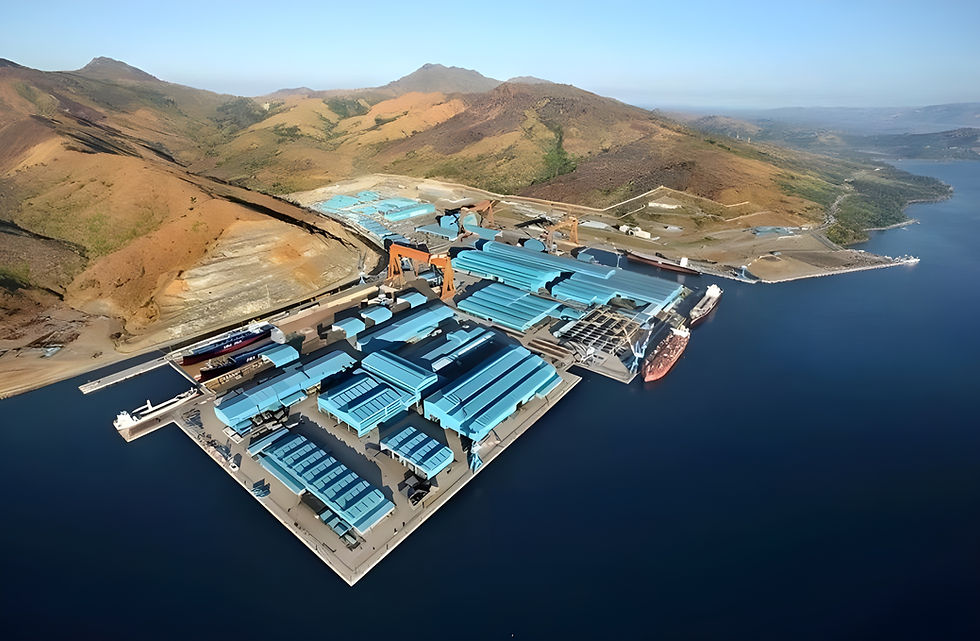Avocado Exports from Africa: Data, Trends, and Investor Opportunity
May 4, 2024

EXECUTIVE SUMMARY
The global avocado market is projected to reach $26.04 billion by 2030, growing at a compound annual growth rate (CAGR) of 7.3%. Africa, already responsible for around 20% of global avocado production, is increasingly positioned to expand its role in global exports. Although projections for Africa’s export-specific growth are not well researched or documented, the continent’s advantages—low labor costs, year-round growing conditions, and increasing demand from Western markets—create an interesting investment thesis for Africa.

Author:
John P. Causey IV
Avocado Exports from Africa: Data, Trends, and Investor Opportunity
Africa produces approximately 1.7 million tons of avocados annually, yet less than 10% is exported. The rest is consumed domestically or lost due to inadequate logistics and market access. By contrast, Latin American countries like Mexico and Peru export the majority of their production.
Despite this, African nations already demonstrate strength in global agricultural exports. They supply 60% of the world's cocoa, 22% of global tea exports, have a 35% market share of exports to the EU, and export more than $1 billion annually of fruits and nuts, and coffee. Avocados represent a high-margin, high-demand opportunity to expand beyond these traditional exports.
KENYA IS AFRICA'S TOP AVOCADO PRODUCER
Kenya is the top avocado producer in Africa, producing roughly 345,000 tons per year. In 2021, Kenya exported 68,000 tons, up from around 26,000 tons in 2016, generating more than $100 million in export earnings. Over 100,000 smallholder farmers participate in the sector, benefiting from high farm-gate prices and growing export access to Europe, the Middle East, and Asia.
Kenya’s proximity to key markets, liberalized export policy, and recent adoption of cold chain logistics make it a key African benchmark.
Kenya is ranked 5th globally in avocado exports, behind Mexico, Peru, Colombia, and the Dominican Republic. While these Latin American countries export the majority of their avocado production, Kenya currently exports only about 20% of its total output. Nonetheless, its share is rising quickly thanks to sustained investment in cold chain infrastructure and compliance with international standards. The bulk of Kenya’s avocado exports go to Europe, particularly France, the Netherlands, and Germany, followed by the Middle East and growing volumes to Asia. In 2022, Kenya became the first African country to gain access to China’s fresh avocado market, marking a major breakthrough in diversifying beyond traditional European buyers. This strategic market expansion has helped Kenyan exporters extend their shipping windows and improve pricing leverage.
Much of Kenya’s avocado industry is built around smallholder participation, which contributes both to inclusive rural income growth and production scale. However, consolidation is underway through increased investment by local and international agribusiness firms, which are introducing high-yield cultivars, quality controls, and traceability systems that meet EU and Chinese market requirements.
PRODUCTION IN AFRICA BEYOND KENYA
South Africa
South Africa is the second-largest avocado producer in Africa, with an output of approximately 125,000 tons in 2021. The industry is export-driven, with nearly 60% of production shipped to international markets, primarily the EU and, increasingly, Asia.
South Africa’s reputation is built on the high quality of its Hass variety, reliable cold chain logistics, and stringent phytosanitary compliance. The South African Avocado Growers’ Association has played a central role in advancing R&D, including rootstock breeding, pest management, and orchard productivity. Despite Kenya status as lead producer, South Africa has the most mature and commercially integrated avocado sector on the continent.
The primary issue South Africa has is a smaller harvest window from Kenya which runs from March to September, overlapping harvest periods of major global producers like Peru and Mexico. Kenya, by contrast, exports earlier during the months of February to May.
In addition to South Africa's unfavorable harvest window, it faces higher land and water constraints compared to Kenya. Additionally, Kenya has done a better job aggressively opening up Asian markets to its Avocado exports, and has lower labor and input costs.
Ethiopia
Ethiopia, by contrast, is a relative newcomer but is gaining investor attention as a counter-seasonal supplier during Latin America’s off-peak months. Avocados grow well in Ethiopia’s highland regions, where the cool climate supports slower maturation and longer shelf life. Government programs, backed by the World Bank and the Netherlands, have prioritized avocado development under national horticulture strategies.
In 2023, Ethiopia exported roughly 4,900 tons of avocados, up from 3,200 tons in 2022, valued at $1.48 million, with most shipments going to Somalia, the UAE, and Saudi Arabia. Though still small in scale, Oromia State alone now cultivates over 30,000 hectares, producing nearly 290,000 tons for the domestic market. Authorities aim to grow export volumes tenfold, targeting 1,200 tons in 2024. Average export prices remain modest at around $634 per ton, reflecting infrastructure gaps.
Ethiopia offers early-stage entry opportunities for investors in cold storage, packhouses, and supply chain logistics.
Morocco & Egypt
Morocco is now recognized as Africa’s third-largest avocado exporter, surpassing 60,000 tons in the 2023/24 season, a 33% rise on the prior year, and reaching over 100,000 tons in 2024/25. Production exceeded 130,000 tons, with export revenues totaling approximately $179 million in 2023/24.
The country ships over 80% of its output to EU markets. Chiefly to Spain, France, and the Netherlands, and has expanded into Switzerland, Belgium, Portugal, Canada, Turkey, Poland, and Malaysia.
Despite a 35% drop in prices in 2024–25, Moroccan avocados remain competitive thanks to short transit times to Europe and a strong focus on higher-margin Hass, which makes up 90% of output. However, rapid growth raises concerns over water use, with 88% of which goes to agriculture.
Egypt is a small avocado producer but is gaining traction. In 2023, Egypt exported around 259 metric tons, valued at $722,000, largely to the UK, Saudi Arabia, Lebanon, and the Netherlands, according to the World Bank. Egypt benefits from its proximity and existing export corridors to the Middle East and Europe.
Other Emerging Producers
Côte d’Ivoire, Tanzania, Ghana, and Uganda are in early stages but moving forward. Côte d’Ivoire has identified avocado as a “champion crop” under its national agricultural plan and is piloting small exports to the EU. Tanzania and Uganda are expanding with donor-supported planting and post-harvest schemes. Although combined export volumes remain under 10,000 tons annually, these regions offer high upside for early investment in nursery systems, supply chain aggregation, and quality compliance infrastructure.
OPPORTUNITY TO INCREASE EXPORTS (EU/US)
European Union
The EU imported approximately 650,000 metric tons of avocados in 2020, mainly from Peru, Mexico, and Israel. Demand has grown steadily, driven by consumer trends around health, sustainability, and plant-based diets. Africa’s proximity and favorable trade terms (e.g., tariff-free access for many countries) give it an edge.
African suppliers are well-positioned to capitalize in the EU. Countries like Kenya and Morocco can reach EU ports in under 10 days by sea, compared to 3–4 weeks from Latin America. This translates to longer shelf life, reduced spoilage, and higher retail margins. Moreover, Africa enjoys tariff-free access to the EU under schemes such as the Everything But Arms (EBA) and Economic Partnership Agreements (EPAs), eliminating duties that can range between 4% and 10% for non-preferential exporters.
United States
Avocado consumption in the U.S. has grown from under 300,000 metric tons in 2001 to over 1.2 million metric tons today. More than 85% of this demand is met by imports, with Mexico accounting for nearly 90% of total U.S. supply. Mexico’s dominance has faced headwinds from labor disputes, cartel-linked supply disruptions in Michoacán (the top growing region), and rising input costs.
Currently, Kenya is the only African country approved for avocado exports to the U.S., after gaining market access in 2022. Initial shipments were modest (under 100 metric tons). In 2023, Kenya shipped its first commercial air-freighted cargo of fresh avocados to Atlanta. Kenya aims to position itself as a niche, high-quality off-season supplier to U.S. buyers, especially on the East Coast. With additional cold-chain and sea freight capacity coming online, volumes are expected to scale steadily over the next 3–5 years.

COMPETITIVE ADVANTAGES FOR AFRICA
Some of these points have been touched on earlier, but it’s useful to consolidate them under one heading for clarity. Africa’s avocado industry benefits from several competitive advantages that position it well in global markets.
Year-round growing capacity. Unlike many regions that have distinct avocado seasons, various African countries produce at different times of the year, helping fill global supply gaps, especially when Latin American output slows. This counter-seasonal production supports more consistent export volumes and builds long-term buyer relationships.
Labor costs. With labor accounting for up to 60% of avocado production costs, Africa’s comparatively lower wages provide producers and investors with better margins than in many Latin American markets.
Geographic proximity. Especially for the European Union. Transport from countries like Kenya or Morocco to EU ports can take under 10 days, far shorter than the three to four weeks required from Peru or Mexico.
Trade access. Many African countries benefit from duty-free access to the EU through agreements like the Economic Partnership Agreements (EPAs) and the Generalized Scheme of Preferences (GSP). Additionally, the African Continental Free Trade Area (AfCFTA) helps reduce intra-African tariffs.
VANTAGE'S TAKE
Africa’s avocado industry is gaining traction, offering higher export margins than many traditional crops. In 2022, Kenya’s avocados averaged $1,750/ton, while South African premium Hass sold for $2,100/ton. These prices reflect strong international demand and limited global suppliers. Africa’s climate supports year-round production, while proximity to Europe allows faster, fresher delivery, often under 10 days from Kenya or Morocco. Lower labor costs also give African producers a margin advantage, with labor comprising up to 60% of production expenses globally. As global buyers seek to diversify sourcing beyond Mexico and Peru, African growers see opportunity. Improved cold-chain capacity and rising volumes from Kenya, Morocco, Ethiopia, and South Africa, the continent is moving in the right direction. Africa’s avocado sector warrants close attention.









